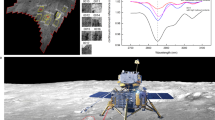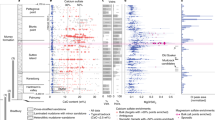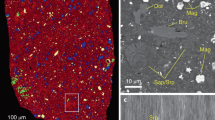Abstract
Once considered dry compared with Earth, laboratory analyses of igneous components of lunar samples have suggested that the Moon’s interior is not entirely anhydrous1,2. Water and hydroxyl have also been detected from orbit on the lunar surface, but these have been attributed to nonindigenous sources3,4,5, such as interactions with the solar wind. Magmatic lunar volatiles—evidence for water indigenous to the lunar interior—have not previously been detected remotely. Here we analyse spectroscopic data from the Moon Mineralogy Mapper (M3) and report that the central peak of Bullialdus Crater is significantly enhanced in hydroxyl relative to its surroundings. We suggest that the strong and localized hydroxyl absorption features are inconsistent with a surficial origin. Instead, they are consistent with hydroxyl bound to magmatic minerals that were excavated from depth by the impact that formed Bullialdus Crater. Furthermore, estimates of thorium concentration in the central peak using data from the Lunar Prospector orbiter indicate an enhancement in incompatible elements, in contrast to the compositions of water-bearing lunar samples2. We suggest that the hydroxyl-bearing material was excavated from a magmatic source that is distinct from that of samples analysed thus far.
This is a preview of subscription content, access via your institution
Access options
Subscribe to this journal
Receive 12 print issues and online access
$259.00 per year
only $21.58 per issue
Buy this article
- Purchase on Springer Link
- Instant access to full article PDF
Prices may be subject to local taxes which are calculated during checkout




Similar content being viewed by others
References
Saal, A. E. et al. Volatile content of lunar volcanic glasses and the presence of water in the Moon’s interior. Nature 454, 192–195 (2008).
McCubbin, F. M. et al. Fluorine and chlorine abundances in lunar apatite: Implications for heterogeneous distributions of magmatic volatiles in the lunar interior. Geochim. Cosmochim. Acta 75, 5073–5093 (2011).
Pieters, C. M. et al. Character and spatial distribution of OH/H2O on the surface of the Moon seen by M3 on Chandrayaan-1. Science 326, 568–572 (2009).
Clark, R. N. Detection of adsorbed water and hydroxyl on the Moon. Science 326, 562–564 (2009).
Sunshine, J. M. et al. Temporal and spatial variability of lunar hydration as observed by the Deep Impact spacecraft. Science 326, 565–568 (2009).
Feldman, W. et al. Fluxes of fast and epithermal neutrons from lunar prospector: Evidence for water ice at the lunar poles. Science 281, 1496–1500 (1998).
Colaprete, A. et al. Detection of water in the LCROSS ejecta plume. Science 330, 463–468 (2010).
McCord, T. B. et al. Sources and physical processes responsible for the OH/H2O in the lunar soil as revealed by the Moon Mineralogy mapper (M3). J. Geophys. Res. 116, E00G05 (2011).
Arnold, J. R. Ice in the lunar polar regions. J. Geophys. Res. 84, 5659–5668 (1979).
Hibbitts, C. C. et al. Thermal stability of water and hydroxyl on the surface of the Moon from temperature-programmed desorption measurements of lunar analog materials. Icarus 213, 64–72 (2011).
Crider, D. H. & Vondrak, R. R. The solar wind as a possible source of lunar polar hydrogen deposits. J. Geophys. Res. 105, 26773–26782 (2000).
Liu, Y. et al. Direct measurement of hydroxyl in the lunar regolith and the origin of lunar surface water. Nature Geosci. 5, 779–782 (2012).
Jolliff, B. L., Gillis, J. J., Haskin, L. A., Korotev, R. L. & Wieczorek, M. A. Major lunar crustal terranes: Surface expressions and crust–mantle origins. J. Geophys. Res. 105, 4197–4216 (2000).
Lawrence, D. J. et al. Small-area thorium features on the lunar surface. J. Geophys. Res. 108, JE002050 (2003).
Pieters, C. M. Bullialdus—strengthening the case for lunar plutons. Geophys. Res. Lett. 18, 2129–2131 (1991).
Tompkins, S., Pieters, C. M., Mustard, J. F., Pinet, P. & Chevrel, S. D. Distribution of materials excavated by the lunar crater Bullialdus and implications for the geologic history of the Nubium region. Icarus 110, 261–274 (1994).
Cahill, J. T. & Lucey, P. G. Radiative transfer modeling of lunar highlands spectral classes and relationship to lunar samples. J. Geophys. Res. 112, 10007 (2007).
Johnson, E. A. in Water in Nominally Anhydrous Minerals Vol. 62 (eds Keppler, H. & Smyth, J. R.) 117–154 (Mineralogical Society of America, 2006).
Wang, K. L., Zhang, Y. X. & Naab, F. U. Calibration for IR measurements of OH in apatite. Am. Mineral. 96, 1392–1397 (2011).
Lucey, P. G., Blewett, D. T., Taylor, G. J. & Hawke, B. R. Imaging of lunar surface maturity. J. Geophys. Res. 105, 20377–20386 (2000).
Cahill, J. T. S., Lucey, P. G. & Wieczorek, M. A. Compositional variations of the lunar crust: Results from radiative transfer modeling of central peak spectra. J. Geophys. Res. 114, 09001 (2009).
Klima, R. L. et al. New insights into lunar petrology: Distribution and composition of prominent low-Ca pyroxene exposures as observed by the Moon Mineralogy Mapper (M3). J. Geophys. Res. 116, E00G06 (2011).
Hapke, B. Theory of Reflectance and Emittance Spectroscopy 2nd edn (Cambridge Univ. Press, 2012).
Lucey, P. G. Model near-infrared optical constants of olivine and pyroxene as a function of iron content. J. Geophys. Res. 103, 1703–1713 (1998).
Libowitzky, E. & Rossman, G. An IR absorption calibration for water in minerals. Am. Mineral. 82, 1111–1115 (1997).
Lawrence, D. J. et al. Improved modeling of Lunar Prospector neutron spectrometer data: Implications for hydrogen deposits at the lunar poles. J. Geophys. Res. 111, E08001 (2006).
Mitrofanov, I. G. et al. Lunar exploration neutron detector for the NASA lunar reconnaissance orbiter. Space Sci. Rev. 150, 183–207 (2010).
Hagerty, J. J. et al. Refined thorium abundances for lunar red spots: Implications for evolved, nonmare volcanism on the Moon. J. Geophys. Res. 111, E06002 (2006).
Papike, J. J., Ryder, G. & Shearer, C. K. in Planetary Materials Vol. 36 (ed. Papike, J. J) 1–189 (Mineralogical Society of America, 1998).
Scholten, F. et al. GLD100: The near-global lunar 100 m raster DTM from LROC WAC stereo image data. J. Geophys. Res. 117, E00H17 (2012).
Acknowledgements
We thank the NASA Lunar Advanced Science and Engineering Program (NNX10AH62G to RK/JHUAPL), the NASA National Lunar Science Institute Polar Exploration Node (NNA09DB31A to JHUAPL) and the NASA Planetary Mission Data Analysis Program (NNH09AL42I to JH/USGS) for supporting this research. We are also grateful to the NASA Discovery Program, Indian Space Research Organization and M3 team.
Author information
Authors and Affiliations
Contributions
All authors contributed extensively to this work. R.K. wrote the main manuscript with comments and feedback from the whole team. R.K. led analysis and modelling of M3 data, J.C. led processing and analysis of LROC data and J.H. and D.L. contributed the thorium analyses and forward modelling.
Corresponding author
Ethics declarations
Competing interests
The authors declare no competing financial interests.
Supplementary information
Supplementary Information
Supplementary Information (PDF 26407 kb)
Rights and permissions
About this article
Cite this article
Klima, R., Cahill, J., Hagerty, J. et al. Remote detection of magmatic water in Bullialdus Crater on the Moon. Nature Geosci 6, 737–741 (2013). https://doi.org/10.1038/ngeo1909
Received:
Accepted:
Published:
Issue Date:
DOI: https://doi.org/10.1038/ngeo1909
This article is cited by
-
Evidence of water on the lunar surface from Chang’E-5 in-situ spectra and returned samples
Nature Communications (2022)
-
Water Group Exospheres and Surface Interactions on the Moon, Mercury, and Ceres
Space Science Reviews (2021)
-
Widespread distribution of OH/H2O on the lunar surface inferred from spectral data
Nature Geoscience (2018)
-
Remote detection of widespread indigenous water in lunar pyroclastic deposits
Nature Geoscience (2017)
-
Active moon: evidences from Chandrayaan-1 and the proposed Indian missions
Geoscience Letters (2014)



